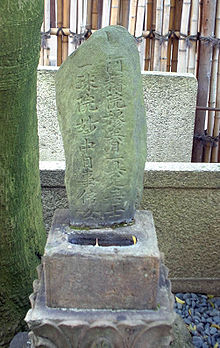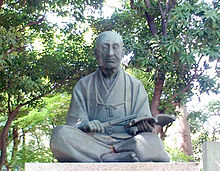
Quick Facts
Biography
Chikamatsu Monzaemon (近松 門左衛門, real name Sugimori Nobumori, 杉森 信盛, 1653 – 6 January 1725) was a Japanese dramatist of jōruri, the form of puppet theater that later came to be known as bunraku, and the live-actor drama, kabuki. The Encyclopædia Britannica has written that he is "widely regarded as the greatest Japanese dramatist". His most famous plays deal with double-suicides of honor bound lovers.
Biography
Chikamatsu was born Sugimori Nobumori to a samurai family. There is disagreement about his birthplace. The most popular theory suggests he was born in Echizen Province, but there are other plausible locations, including Hagi, Nagato Province. His father, Sugimori Nobuyoshi, served the daimyō Matsudaira in Echizen as a medical doctor. Chikamatsu's younger brother became a medical doctor, and Chikamatsu himself wrote a book on health care.

In those days, doctors who served the daimyōs held samurai status. But Chikamatsu's father lost his office and became a rōnin, a masterless samurai. At some point in his teens, between 1664 and 1670, Chikamatsu moved to Kyoto with his father where he served for a few years as an obscure page for a noble family, but other than that, little is known about this period of Chikamatsu's life. He published his first known literary work in this period, a haiku that appeared in 1671. After serving as a page, he next appears in records of the Gonshō-ji (近松寺) temple (long suggested as the origin of his pen name "Chikamatsu", which is kun reading of 近松) in Ōmi Province, in present-day Shiga Prefecture.
With the production in 1683 of his puppet play in Kyoto about the Soga brothers, (The Soga Successors or "The Soga Heir"; Yotsugi Soga) Chikamatsu became known as a playwright. The Soga Successors is believed to have been Chikamatsu's first play although sometimes 15 earlier anonymous plays are contended to have been by Chikamatsu as well. Chikamatsu also wrote plays for the kabuki theatre between 1684 and 1695, most of which were intended to be performed by a famous actor of the day, Sakata Tōjūrō (1647–1709). After 1695, and until 1705, Chikamatsu wrote almost exclusively Kabuki plays, and then he abruptly almost completely abandoned that genre. The exact reason is unknown, although speculation is rife: perhaps the puppets were more biddable and controllable than the ambitious kabuki actors, or perhaps Chikamatsu did not feel kabuki worth writing for since Tōjūrō was about to retire, or perhaps the growing popularity of the puppet theater was economically irresistible.
In 1705, Chikamatsu became a "Staff Playwright" as announced by early editions of The Mirror of Craftsmen of the Emperor Yōmei. In 1705 or 1706, Chikamatsu left Kyoto for Osaka, where the puppet theater was even more popular. Chikamatsu's popularity peaked with his domestic plays of love-suicides, and with the blockbuster success of The Battles of Coxinga in 1715, but thereafter the tastes of patrons turned to more sensational gore fests and otherwise more crude antics; Chikamatsu's plays would fall into disuse, so even the actual music would be lost for many plays. He died January 6, 1725, in either Amagasaki in Hyōgo, or Osaka.
Chikamatsu was the first known Japanese playwright who did not act in the pieces he wrote. Currently, 130 plays have been verified to have been authored by Chikamatsu, with another 15 plays (mostly early Kabuki works) suspected to also have been penned by him.
Japanese composer Mayako Kubo wrote an opera based on Chikamatsu's play Osan: Secret of Love. It premiered at the New National Theatre Tokyo in 2005.
Quotations
- "Art is something that lies in the slender margin between the real and the unreal." — Chikamatsu Monzaemon, Naniwa Miyage
References in popular culture
- In the fictional world of Naruto, the first ninja puppeteer is named Chikamatsu Monzaemon, a reference to Chikamatsu's puppet plays.
- In the Digimon multimedia franchise, a puppet Digimon by the name of Monzaemon—an obvious homage to Chikamatsu—was one of the first characters in the original line of virtual pets.
- Masahiro Shinoda's celebrated 1969 film, Shinjū: Ten no Amijima (billed in English as Double Suicide) employs cinematic techniques based on Bunraku conventions and takes as its basis a Chikamatsu play.
Major works

Jōruri
- The Soga Successors or "The Soga Heir" (Yotsugi Soga 世継曾我) (1683)
- Kagekiyo Victorious (Shusse kagekiyo 出世景清) (1685)
- The Love Suicides at Sonezaki (Sonezaki shinjū 曾根崎心中) (1703)
- The Night Song of Yosaku from Tamba (Tamba Yosaku machiyo no komurobushi 丹波与作待夜のこむろぶし)
- The Courier for Hell (Meido no hikyaku 冥途の飛脚) (1711)
- The Battles of Coxinga (Kokusen'ya kassen 国姓爺合戦) (1715)
- The Uprooted Pine (Nebiki no Kadomatsu 寿の門松) (1718)
- The Love Suicides at Amijima (Shinjū Ten no Amijima 心中天網島) (1720)
- The Woman-Killer and the Hell of Oil (Onnagoroshi abura no jigoku 女殺油地獄) (1721)
Kabuki
- The Courtesan on Buddha Plain[1] (Keisei hotoke no hara けいせい仏の原) (1699)
Critical work
- Naniwa Miyage (1738; written by a friend and preserving a number of statements by Chikamatsu on the art of the puppet theater)
Translations into English
- Major Plays of Chikamatsu, translated and introduced by Donald Keene. NY: Columbia University Press. 1961/1990.
- Chikamatsu: Five Late Plays, translated by C. Andrew Gerstle. 2001.
